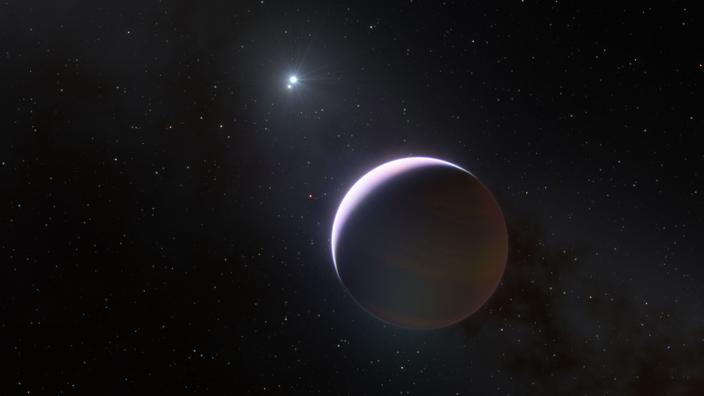It should not exist, and yet, "
b Cen (AB) b
", a giant super-Jupiter-type planet orbits a very massive star system, in the constellation Centaur, according to a study unveiled Wednesday, December 8.
Read also A giant planet surrounded by three suns
The pair of stars, dubbed “
b Cen
”, weighs heavily, with a mass six to ten times that of the Sun. However, until now, no planet had been detected around a star system of more than three solar masses. Such stars "
form an environment considered to be quite destructive and dangerous, to the point where it was thought very difficult for large planets to form there
," said astronomer Markus Janson of Stockholm University, lead author. of the study published in Nature, and cited by the European Southern Observatory (ESO). The brightest twin stars of "
b Cen
- about 325 light years from Earth - radiates at an estimated surface temperature of over 18,000 degrees Celsius, more than three times that of the Sun.
When the latter was still in formation, its protoplanetary disk, a cloud of gas and dust, saw the formation of planets, Jupiter at the head, by agglomeration of dust.
Its rocky core then accelerated the gas that today forms the most massive planet's atmosphere in the solar system.
But stars like "
b Cen are so hot and bright that their light blows matter around them and there isn't enough to form a rocky heart
" nearby, the astronomer told AFP from CNRS Gaël Chauvin, stationed at the Franco-Chilean Mixed Astronomy Unit, co-author of the study.
Among the giant gas planets
So, "
what planet formation mechanism is at work in such a hostile environment, due to the very strong radiation?
“Asks the researcher. Because if the theory made the formation of a planet around a massive star hardly credible, it was "
caught up by observation
". Namely that of the Very Large Telescope of ESO, in Chile, and its instrument SPHERE. The planet he imaged enriches the planetary bestiary with remarkable characteristics. "
B Cen (AB) b
" belongs to the same species as Jupiter, that of the gas giants, but it is almost eleven times its mass. Above all, the distance separating it from its pair of stars is colossal, 100 times that separating Jupiter from the Sun.
It was first necessary to ensure that despite this distance, the star was indeed in orbit around the stars of "
b Cen
". And there, surprise, an archive work established that the planet had been observed but not identified as such by a small ESO telescope, twenty years ago ... The comparison with 2000 confirmed the proper movement of planet, and shown to move in the same way as its host star. So in orbit.
As to how it was able to be formed, "
there is no privileged scenario
,"
he
adds.
The observed system may be young, barely 15 million years old, it is already in place.
We should be able to observe an alter ego in full genesis, only one to two million years old.
To appear, "
b Cen (AB) b
" could have formed a rocky core by agglomeration of dust at a sufficiently large distance from its pair of stars, or else by a phenomenon of gravitational instability, in which part of the cloud of dust suddenly collapsed on itself.
Read also Jupiter, a giant planet full of mysteries
The quest has only just begun.
The international team around Markus Janson will seek to know the chemical composition of the planet.
This could point to a preferred training scenario.
Answer within a few years.

